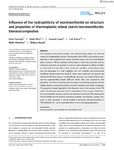Influence of the Hydrophilicity of Montmorillonite on Structure and Properties of Thermoplastic Wheat Starch/Montmorillonite Bionanocomposites

Use este enlace para citar
http://hdl.handle.net/2183/28731
A non ser que se indique outra cousa, a licenza do ítem descríbese como Attribution 4.0 International (CC BY 4.0)
Coleccións
Metadatos
Mostrar o rexistro completo do ítemTítulo
Influence of the Hydrophilicity of Montmorillonite on Structure and Properties of Thermoplastic Wheat Starch/Montmorillonite BionanocompositesData
2021-11Cita bibliográfica
Derungs I, Rico M, Lopez J, Barral L, Montero B, Bouza R. Influence of the hydrophilicity of montmorillonite on structure and properties of thermoplastic wheat starch/montmorillonite bionanocomposites. Polym Adv Technol. 2021;32(11):4479-4489. https://doi.org/10.1002/ pat.5450
Resumo
[Abstract] The increasing environmental pollution with petroleum-based plastics has advanced research on biodegradable polymers. Thermoplastic starch (TPS) is one promising candidate due to wide availability from various renewable sources, low cost and biodegradability. However, TPS has significant shortcomings, as high water sensitivity and low mechanical properties. An approach to overcome these drawbacks is adding nanofillers as reinforcement of the starch matrix. Among the nanofillers, montmorillonite clays have the advantages of a wide availability, low cost, versatility and environmental friendliness. Bionanocomposites based on wheat starch plasticized with glycerol and reinforced with three types of montmorillonite nanoclays, one natural (Cloisite Na+) and two organomodified (Cloisite 30B and Cloisite 10A), were prepared by melt processing. The effect of nanoclay type and amount on processing properties, thermal stability, dynamic mechanical properties and water absorption was widely investigated. The properties strongly depended on the dispersion state of the nanoclay in the TPS matrix. The dispersion improved with the hydrophilicity of the nanoclay. Cloisite Na+, the most hydrophilic nanoclay, was the most effective in reinforcing TPS, improving the thermal stability and the dynamic mechanical properties, and showing a greater resistance to water absorption in normal humidity environments. Bionanocomposites of TPS andCloisite Na+ can be a good alternative for use in packaging applications.
Palabras chave
Bionanocomposites
Montmorillonite clay
Thermoplastic starch
Montmorillonite clay
Thermoplastic starch
Descrición
Financiado para publicación en acceso aberto: Universidade da Coruña/CISUG
Versión do editor
Dereitos
Attribution 4.0 International (CC BY 4.0)
ISSN
1099-1581






